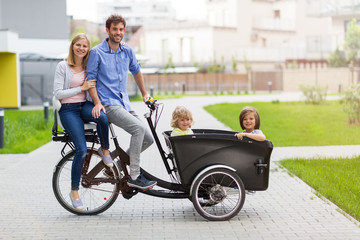When you are looking to buy an electric bicycle, one of the most important factors is the weight limit of the bike. It’s important to find out if the bike can support your weight and if it has enough power to run up hills. An e-bike with a higher capacity battery will allow you to go further before needing a recharge or heavy pedaling, but this may mean that it costs more money.
How Much Weight Can an Electric Bike Carry?

You can carry a maximum of about 200 kg on an electric bike, which is the recommended weight limit. The battery and motor are what give it its extra power, so if you want to be able to ride at 24mph, you need to keep the weight as low as possible. However, the weight limit will vary depending on the model. Most e-bikes have a maximum weight limit of around 200 kg and some can carry up to 250 kg.
Can 2 People Ride on An e-Bike?
Yes, you can add a passenger seat and carry someone else with you on your bike. It’s a great way to share the experience of riding an e-bike, as well as make it easier and safer to get around with two people versus just one. However, while this feature is available on most modern models, there are some limitations that you should be aware of. For one, your bike’s weight limit will go down considerably from 220 kg to 180kg when you add a passenger seat.
What Happens if You Exceed the Weight Limit on An e-Bike?
If you exceed the weight limit on your bike, it can cause serious problems down the line. Here are a few reasons you should avoid exceeding the weight limit of your bike:
Negatively impacts battery life
The battery life of an electric bike is reduced when you begin to use it above the intended purpose. This means the amount of use you will get out of the bike on a single charge will lessen. This metric will decrease even further if you are using your electric bicycle to tow items. If you’re going up hills, this can be quite noticeable as well.
Reduces maximum speed
Regularly exceeding the maximum weight recommendation puts undue strain on the bike’s motor and motor controller. The amount of power that a thrust can provide will be lessened, resulting in a decreased maximum speed. You could also struggle to ascend steep inclines and traverse rougher-than-average terrain types.
Given enough strain, particularly if it occurs over an extended period of time, these components may prematurely degrade as well as cause other parts such as tires or brakes to wear out more quickly than normal due to their increased use under heavy loads versus lighter ones where they would not have been taxed quite so much.
Strain the brakes
One of the most important parts of an electric bicycle is its brakes. Without them, you can’t stop your bike or slow down as quickly. So it makes sense that when you exceed the maximum weight limit for your electric bike, one of the first things that will suffer is your braking system. Excess weight on a bike causes damage to both mechanical and hydraulic components in a braking system.
Lead to wear and tear on the gears
Overloading an electric bike can put an inordinate amount of strain on nearly every component of an electric bicycle. This includes the gears, the chains, the wheels, the rims, the saddles, and the handlebars. The more a part is stressed and pushed to its limits by a heavy load for extended periods of time, it is going to wear out faster than normal.
Gear damage will occur if a load that is too heavy is placed on the bike, which could result in a broken chain or gears shifting abruptly during riding. Frame failure can occur when an excessive load causes stress fractures in either one or multiple parts of the frame structure itself
How to Find the Weight Limit on A Specific E-Bike
The easiest way to find the weight limit on a specific electric bicycle is to check the user manual and/or manufacturer’s website. Some bikes have weight limits printed in their manuals, while others will list them on their websites.
If you don’t have access to either of these resources, you may need to ask a retailer for help. However you find out about it, always be sure that any e-bike you’re interested in is appropriate for your needs before buying it.
How to Choose an e-Bike for A Heavy Rider
If you are a heavy rider or need to carry heavy cargo, you will want a bike that can handle the extra weight. When choosing an electric bike for your needs, consider the following:
Bike frames
The type of frame you choose will also determine how much weight your electric bike can carry. A strong frame is important for both comfort and stability as it allows you to ride confidently with no worries about falling off your bike.
Most bikes have steel frames, while some have aluminum or carbon fiber frames. Aluminum is lighter and more durable than steel but not as strong as carbon fiber, which makes it a great choice for riders who need durability without having to sacrifice too much weight on their ride. Steel is the most common option because it’s both sturdy and relatively inexpensive.
Bike wheels
Wheels are the most important part of an electric bike. It’s good to go for a 26” wheel instead of a 29″, as smaller wheels tend to be stronger than bigger ones. Strong wheels are also important as they will help absorb bumps in the road and carry additional weight without breaking down or requiring frequent maintenance.
The number of spokes in a wheel is proportional to its weight-bearing capacity, so the more spokes you have, the more weight it can carry. Choosing wheels with at least 25 spokes per wheel if you weigh over 170 lbs., as they offer more stability than those with fewer spokes.
Bike style
The style of your bike will affect how much weight you can carry on it, as well as how much comfort you have while riding. Road bikes are typically more narrow and require being more hunched over the handlebars than other styles. This position can make it difficult for larger riders to maintain their balance when going uphill or downhill, which makes them less suitable for heavier people.
Mountain bikes generally have a larger wheel size than road bikes in order to give riders better traction over rough terrain. If a mountain bike weighs less than 28 pounds, then it might not be able to support an overweight person’s weight when going up hills or down steep slopes – even if the tires are wide enough.
Brakes
Disc brakes are usually more powerful than rim brakes and can last longer. They also weigh more, which is bad for the bike’s performance but good if you’re on the heavier side. Hydraulic disc brakes as they have better reliability and pack more stopping power. Mechanical disc brakes are much cheaper and easier to maintain but might not be powerful enough to stop the bike immediately.
Suspension
Suspension is a feature that can help to make your ride more comfortable and help to reduce the impact of bumps and vibrations. It helps you absorb shocks through small movements within the bike’s frame, which means that your body doesn’t have to take these impacts directly. The suspension also reduces fatigue as it reduces muscle strain from riding over rough terrain, which also helps you avoid injury.
Conclusion
The weight limit of an electric bicycle depends on many factors. The weight limit is based on the bike frame, wheels, style, and brakes. You can go online and check out the different models available, or contact your local e-bike shop for more information.
